15 Best Blue Gourami Tank Mates – FishLab
When you purchase through links on our site, we may earn a commission. Here’s how it works.
Putting together a community tank requires a lot of background research on every species you want to house. Any misstep could mean total disaster for you, your fish and their watery environment. Blue gourami are one such fish that can easily freak out or quickly become dinner if their tank mates aren’t appropriate.
We’ll discuss the best blue gourami tank mates. These include blue tetras, the common pleco, pineapple swordtails and a couple snails, just to name a few. While these will give a brief overview of each compatible tank mate, fish keeping hopefuls should do deeper research into each.
Table of Contents
What You Need To Know
To ensure you house the right fish with your beautiful blue gourami, you have to understand how this fish behaves, its size and the types of fish it won’t like. This includes water parameters and tank setup.
Temperament
Blue gouramis are famous for their peaceful temperament and friendly disposition swimming around the center of the tank. This is what makes them appropriate for almost any community tank. Having said all that, there may be some instances of infighting with pairs or groups of blue gouramis.
This is because males are territorial, especially during breeding. Here, they’ll project some aggressive behaviors to any fish in their way, even females. Regardless, they’re usually very laid back while nipping plants for algae.
Size
You can expect your blue gourami to get a as long as five to six inches. Females are a little larger, but the difference between the genders isn’t noticeable.
Competition
While you can estimate blue gourami to be peaceful and friendly, you still have to watch what tank mates you choose. Never keep species that are smaller or larger than they are. Either the blue gouramis will get roughed up or be the recipient of it. Therefore, no dwarf gouramis, bettas, guppies, goldfish or angelfish.
Parameters ; Tank Setup
The wonderful thing about blue gouramis is how they are tolerant of a wide range of water parameters. This opens up many options for potential tank mates. However, you should always provide the precise things they like to ensure their happiness and survival.
Their native habitat is Indonesia and South Asia. Therefore, the waters are warm and balmy. The sweet spot for temperature for them is around 76°F with a neutral pH and a hardness of 7 dKH.
Also, make sure you have a thermometer, water test kit, water pump, quality filter, decorations and some plants. It is advisable to use a substrate with a darker color so they can see the bottom.
15 Best Blue Gourami Tank Mates
Also, don’t miss out on these other popular posts:
1. Blue Tetra
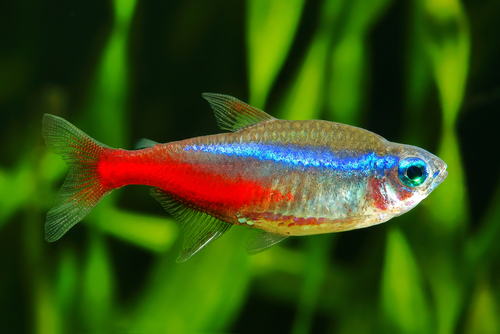
- Scientific Name: Knodus borki
- Adult Size: About 2 inches
- Compatible with: Blue Gourami
- Care Level: Easy
- Origin: Peru
Blue tetras love a well-planted tank, just like blue gouramis. Even though these two come from different corners of the world, they adore very similar water parameters. So, it will be easy to keep them both happy and healthy. Plus, the size of blue tetras aren’t so small that the blue gourami will bully it.
These very attractive fish have a blue iridescent color that changes to a blue-green turquoise-like hue in the light. The only pitfall is that blue tetras tend to be aggressive. However, if there are enough plants and space, this should be minimal.
Pros
Both species look beautiful together.
Cons
They tend to be aggressive, especially the males.
2. Upside Down Catfish
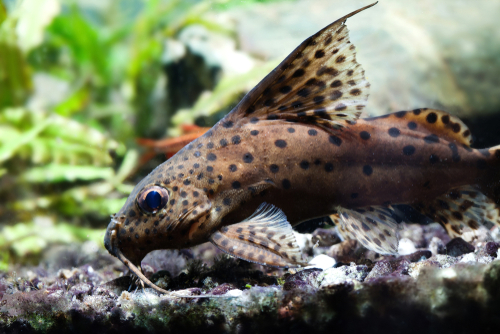
- Scientific Name: Synodontis nigriventris
- Adult Size: Up to 10 inches
- Compatible with: Blue Gourami
- Care Level: Easy
- Origin: Central Africa
Even though upside down catfish can get enormous (and perhaps too much for blue gouramis), they are bottom feeders and love to hide. So, as long as they have an abundance of sandy substrate, plants and crevices, they’ll do well together. However, these catfish love meaty offerings and will eat smaller fish if nutrition is insufficient.
Pros
Make a curious yet peaceful addition to a community tank.
Cons
Smaller fish will become a meal if nutrition is insufficient.
3. Harlequin Rasbora
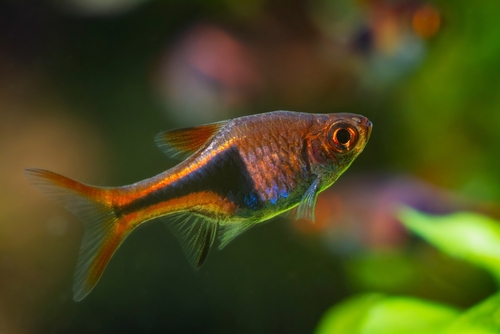
- Scientific Name: Trigonostigma heteromorpha
- Adult Size: About two inches
- Compatible with: Blue Gourami
- Care Level: Easy
- Origin: Southeast Asia
What makes the harlequin rasbora such a great tank mate for blue gouramis is they have near exact preferences for food and water parameters. They’re not too big or small for the blue gourami to see them as a threat. However, if their environment isn’t suitable, they will attack each other.
Pros
Both are adaptable to a wide range of water parameters with a similar diet.
Cons
Aggression occurs if there isn’t enough hiding spots or territory.
4. Common or Suckermouth Pleco
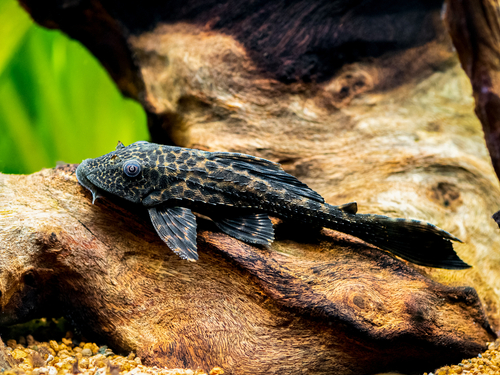
- Scientific Name: Hypostomus plecostomus
- Adult Size: Up to 24 inches
- Compatible with: Blue Gourami
- Care Level: Easy
- Origin: South America
Another great bottom feeder for blue gouramis is the common pleco. They are not aggressive at all and only fight with other plecos when provoked. They love minding their own business in the substrate. Although their ginormous size is alarming, blue gouramis will avoid it.
In terms of food, they feed on algae and any leftover food that falls to the bottom of the tank. So, they aren’t likely to leave the bottom just to eat a blue gourami swimming around in the middle of the tank.
Pros
Plecos are one of the most peaceful fish to have in any community aquarium.
Cons
Their large size may cause stress to blue gouramis.
5. Pineapple Swordtail

- Scientific Name: Xiphophorus Helleri
- Adult Size: Up to four inches
- Compatible with: Blue Gourami
- Care Level: Easy
- Origin: Malaysia and Singapore
The pineapple swordtail’s red-orange iridescent sheen makes a handsome accent against blue gouramis. Besides, they both have the same preferences for food as well as water parameters. However, pineapple swordtails can get somewhat aggressive, but this is mostly with swordtails.
Pros
They are easy to care for with similar requirements as blue gouramis.
Cons
Can be aggressive toward blue gouramis if the tank isn’t large enough.
6. Cory Catfish
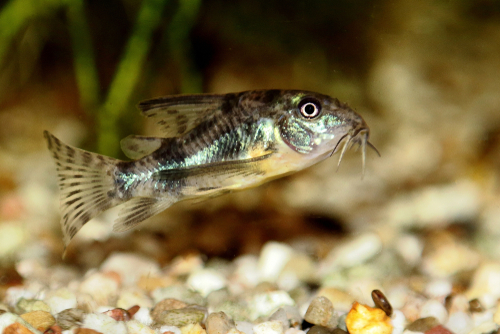
- Scientific Name: Corydoras
- Adult Size: 2½ inches
- Compatible with: Blue Gourami
- Care Level: Moderate to Intermediate
- Origin: South America
Cory catfish is a whole genus and any variety will make an excellent tank mate for blue gouramis, although they hail from a different area in the world. However, they are fussy about their environment, being sensitive to slight changes in water parameters. Regardless, the cory catfish is a bottom feeder, so it won’t bother blue gouramis.
Pros
Cory catfish are unintimidating and mind their own business.
Cons
Particular about water parameters once introduced to a specific environment.
7. Purple Passion Danio
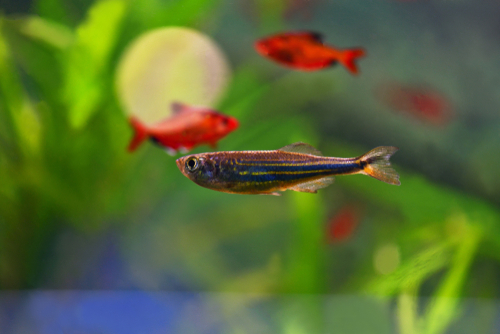
- Scientific Name: Brachydanio roseus or Danio roseus
- Adult Size: Up to 2½ inches
- Compatible with: Blue Gourami
- Care Level: Moderate
- Origin: Myanmar, Laos and Thailand
Both blue gouramis and purple passion danios enjoy a dark substrate and heavily planted environment, which makes them perfect for cohabitation. As long as there is room and hiding spots, the chances for clashes are low. However, aggression is high during breeding.
Pros
The size and temperament of purple passions are equal to blue gourami.
Cons
Breeding season may provoke aggression in both species.
8. Pearl Danio
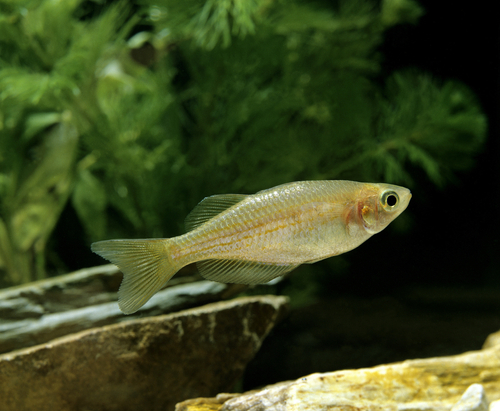
- Scientific Name: Danio albolineatus
- Adult Size: Up to two inches
- Compatible with: Blue Gourami
- Care Level: Easy
- Origin: Sumatra, Thailand and Burma
Because pearl danios and blue gouramis come from neighboring areas, they have very similar preferences. Plus, they’re both peaceful and tolerant of a wide range of water conditions. So, if you’re looking to house more than two species, pearl danios are ideal.
Pros
Pearls are schooling fish and must have a group that encompasses five to eight individuals.
Cons
If the tank is too small, it will cause stress to both blue gouramis and pearl danios.
9. Platy
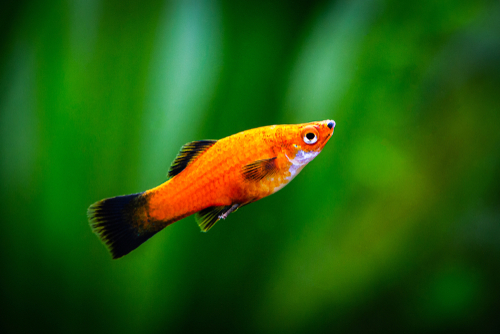
- Scientific Name: Xiphophorus
- Adult Size: 1½ to 3 inches
- Compatible with: Blue Gourami
- Care Level: Easy
- Origin: South America
Platy fish are an entire genus with many varieties, all of which are excellent to put into the same aquarium as blue gouramis. They’re peaceful, unimposing and are very hardy, being able to survive in a wide range of water parameters.
Pros
Everything about these two species are excellent with each other.
Cons
A lack of plants will cause a platy to stress in a community aquarium.
10. Clown Loach

- Scientific Name: Chromobotia macracanthus
- Adult Size: Two to three inches, but up to 12 inches
- Compatible with: Blue Gourami
- Care Level: Easy
- Origin: Indonesia
An excellent tank mate for blue gouramis is clown loaches. These are interesting-looking fish, complete with reddish orange bodies, black stripes and cute fangs that hang down outside their mouths. Regardless of their appearance, clown loaches are very peaceful, fun fish.
Pros
Both clown loaches and blue gouramis come from Indonesia, making water and food easy.
Cons
While clown loaches won’t both blue gouramis, their size may cause intimidation.
11. Zebra Loach
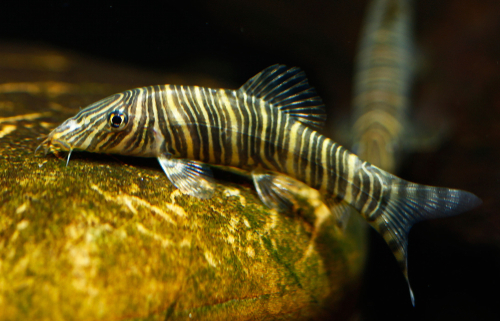
- Scientific Name: Chromobotia macracanthus
- Adult Size: Up to four inches
- Compatible with: Blue Gourami
- Care Level: Easy
- Origin: Indonesia; Borneo and Sumatra
Zebra loaches are excellent for blue gouramis. They never get bigger than four inches, adhering to a sense of peace and calm. In fact, they avoid confrontation whenever possible. So, the risk of them battling with the blue gourami is next to null, especially since zebra loaches stay at the bottom.
Pros
They share a love of similar water parameters
Cons
Zebra loaches do not fare well with other bottom feeders
12. Discus
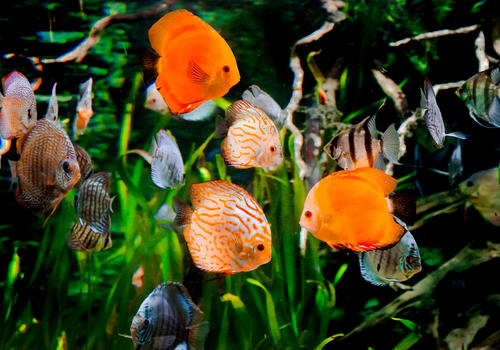
- Scientific Name: Symphysodon
- Adult Size: Up to eight inches
- Compatible with: Blue Gourami
- Care Level: Moderate
- Origin: South America
While the entire genus of discus is much more high maintenance than blue gouramis, they can live together quite peaceably. The only time you’ll see a discus get aggressive is during breeding time. Also, they do have a different diet and require a high-quality flake with meaty offerings.
Pros
Both have similar water parameter preferences.
Cons
Discus fish have specific food requirements and are higher maintenance.
13. Tiger Barb
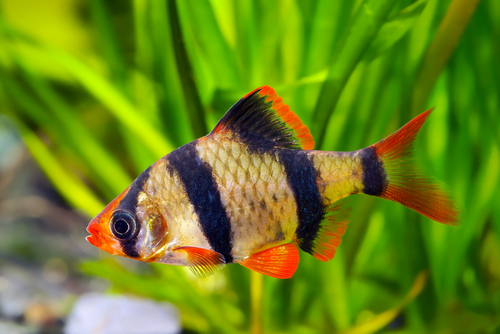
- Scientific Name: Puntigrus tetrazona
- Adult Size: Up to three inches
- Compatible with: Blue Gourami
- Care Level: Easy to Moderate
- Origin: Indonesia; Boreno and Sumatra
Tiger barbs are playful fish and perfect to house with blue gouramis. This is because they come from the same freshwater areas. Ergo, they have similar temperaments and water parameter preferences as well as food requirements. However, they like things a little more acidic in their watery environment.
Pros
Both fish have similar requirements.
Cons
They must have room or they will become aggressive toward blue gouramis.
14. Mystery Snails
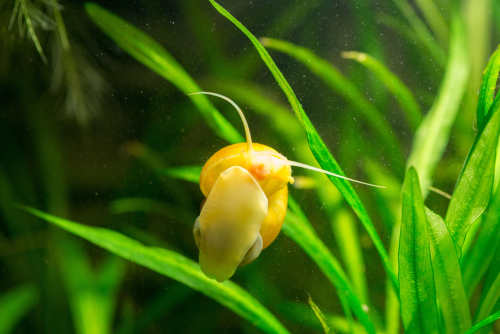
- Scientific Name: Pomacea bridgesii
- Adult Size: Up to two inches in diameter
- Compatible with: Blue Gourami
- Care Level: Easy
- Origin: South America
Mystery snails are awesome tank mates for blue gouramis. They’re peaceful and don’t have any interest in what happens inside the tank with other species. If a gutsy gourami wants to bully the mystery snail, it will just take cover in its shell. But, they love to be on the bottom of the tank, so this would be a rare occurrence.
Pros
Don’t have the desire to bother themselves with any other fish in the tank.
Cons
They only live for one year.
15. Nerite Snails
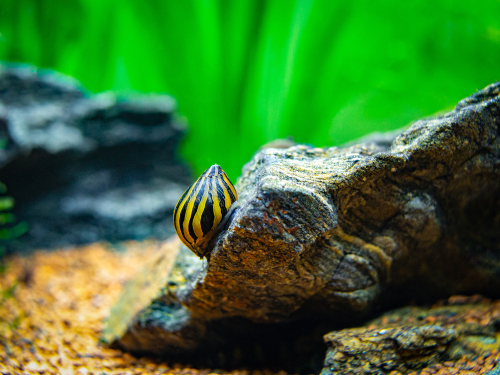
- Scientific Name: Vittina natalensis
- Adult Size: One inch
- Compatible with: Blue Gourami
- Care Level: Easy
- Origin: Eastern Africa and near Indonesia
While the nerite snail is almost too small for a blue gourami, they usually just do their own thing and mind their own business. Often found nearer to the bottom, the chances of these two bothering each other aren’t likely.
Pros
Easy to care for and won’t bother blue gouramis.
Cons
They tend to like a more acidic environment.
Summary
If these 15 best blue gourami tank mates don’t fit in with your ideal aquascape, many other fish will work as well. Ensure prospective fish won’t cause stress to your blue gouramis or trigger their inner bully. Also, ensure their water parameters match up. This includes temperature, plants, pH balance and hardness.
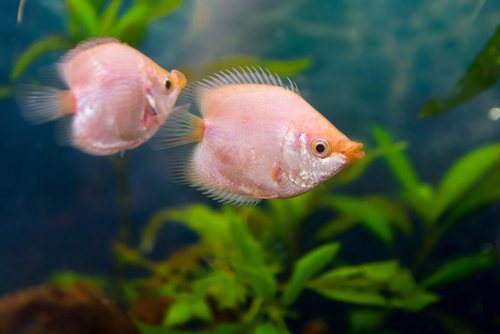
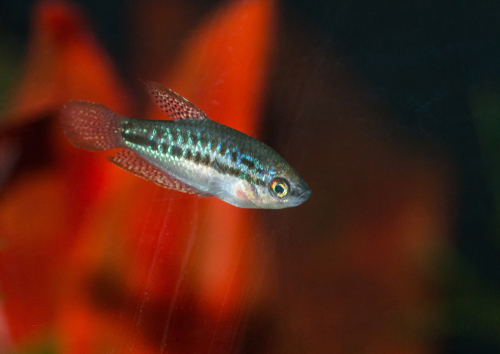
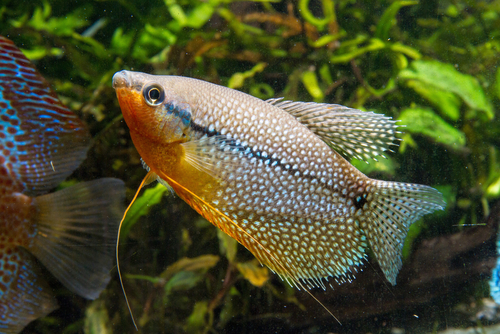
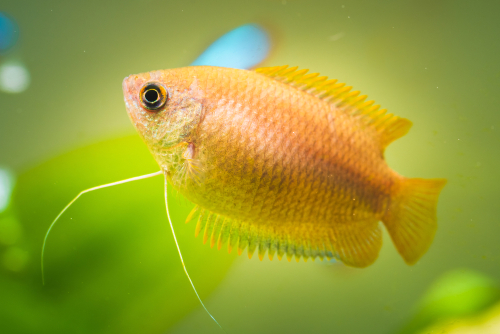
I have a male 3spot blue gourami named [KINGBLUE🔵👑] 2 females a 3spot blue named (tigressblue💙) a female opaline gourami named (skyyblue💙) 2 blackskirt tetras and 1 single male southern American republican🚩 festivum cichlid named professor {hector eddgor} he will be forever single cause I don’t breed republicanfish.
This might be one of the most iconic tank casts we’ve ever heard! From KINGBLUE🔵👑 to the no-nonsense Professor Hector Eddgor, every fish has a full-on personality. Love that you’re giving them such fun, expressive names. How’s the vibe in your tank with that mix? Gouramis can be a little bossy, but it sounds like you’ve built a cool balance! 💙🐟👑